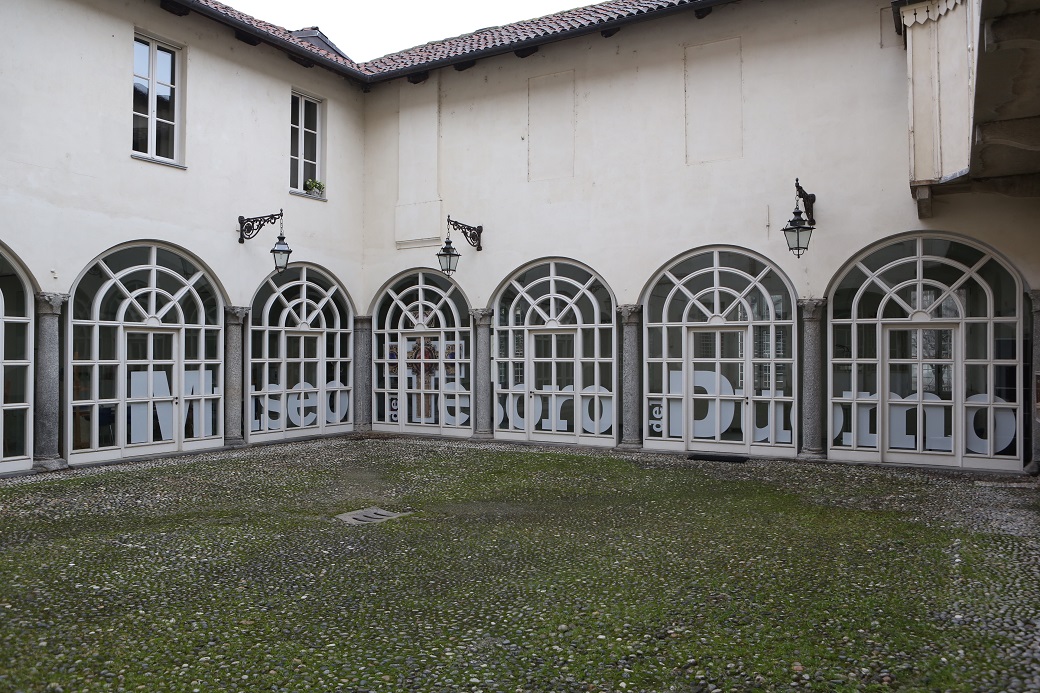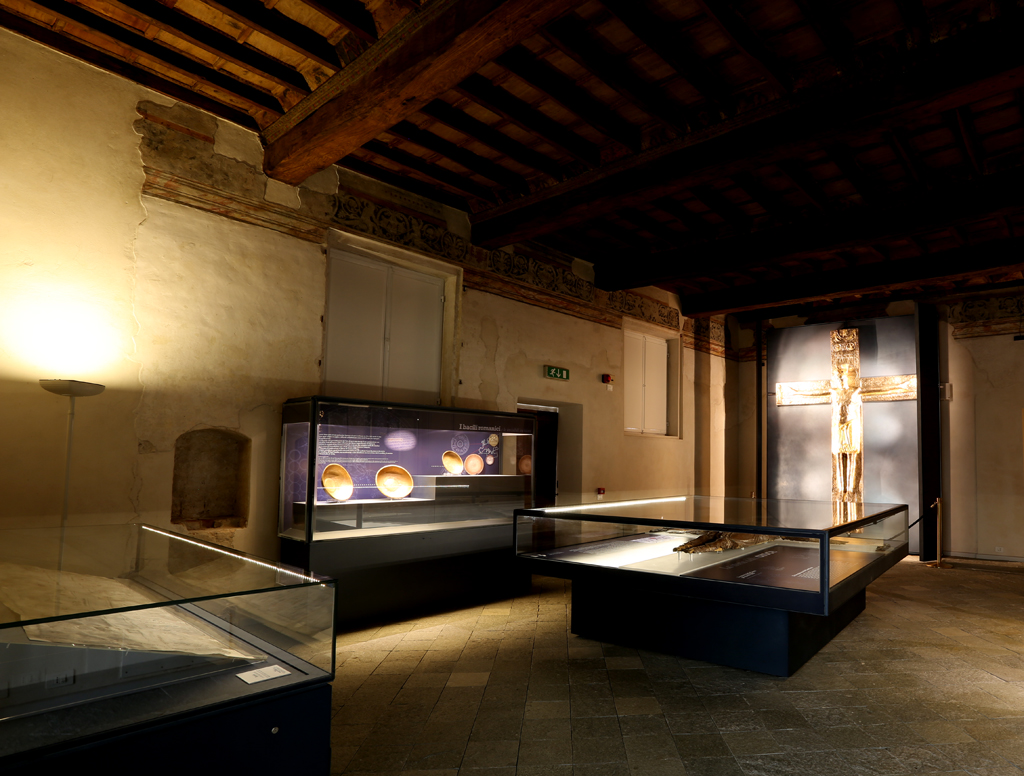
Archbishop’s Palace, Cathedral Treasury Museum, Archiepiscopal Art Gallery, Archives and Capitular Library of Vercelli
This post is also available in:
 Italiano (Italian)
Italiano (Italian)
The Archiepiscopal Palace Museum of the Treasure of the Cathedral of Vercelli was built in 1452, on the foundations of a previous building erected before 1152.
It has a trapezoidal base and, on the façade, several multi-lancet and Guelph cross windows embellished with terracotta frames. In the atrium, there are some valuable frescoes of the XV century. A staircase leads to the Throne room, with coffered ceiling, coats of arms, monograms and mottos, and where some works of art of the Vercelli school of painting are preserved.
On the left, visitors can enter the chapel of the Annunciation and then reach the Hall of the Cross or the Audience, the Savoy apartment and the Bishops’ Library.
The Palace houses the Museum of the Treasure of the Cathedral of Vercelli arranged through some rooms on the ground floor and partly frescoed in the XVI century; two other rooms on the first floor have been recently annexed. On the ground floor, there are the Archives and the Capitular Library, while the Archiepiscopal Art Gallery can be found on the first floor.
Treasury Museum of the Cathedral – the tour
At the beginning of the tour, visitors can admire the splendid pastoral staff in finely crafted silver, commissioned by Monsignor Agostino Ferrero and donated to Vercelli cathedral along with other masterpieces made of gold.
The first room houses precious gold and silver foil bindings, like those of the Codex Vercellensis Evangeliorum. In the same room, there is also a copy of the Crucifix and the original “filling” in cocciopesto (opus signinum, an ancient building material made of tiles broken up into very small pieces, mixed with mortar, and then beaten down with a rammer) and organic resins.
In the second room, there are several reliquaries: boxed, covered with ivory plaques or decorated with polychrome enamels, anthropomorphic, with embossed decorations and filigree, in the shape of a newsstand, and zoomorphic.
Some other exquisite works of art include the lead box with the remains of St. Eusebius and the silver case donated to the cathedral in 1619 by Carlo Emanuele I.
The third and last room offers three engraved copper basins, two with the apocryphal stories of St. Thomas in India and a third one with the allegorical depiction of the vices.
Special Initiatives
The true wealth of exhibits makes it possible to organize all kinds of events dedicated to difference audiences – they’re often carried out in collaboration with other organizations and included in the “Passeggiando tra Sacro e Profano” museum circuit. In addition to guided tours and educational workshops usually offered to schools of all levels, visits are often themed on particular instructional needs and aims, as well as special conference and activities for the adults.
The Museum is also open to new technological frontiers in the field of conservation and study of the cultural heritage as it is often part of national and international scientific projects.
The Archiepiscopal Picture Gallery
On the upper floor of the Archbishop’s Palace, there is the “Pinacoteca” (the “picture gallery”), which includes works of art chronologically arranged between the XV and XVIII centuries.
Archives and Capitular Library
Reopened to the public in the new headquarters on 1 September 1998, the Archives are located on the ground floor of the Archbishop’s Palace. In addition to parchments and paper documents between the VII and the XIX century, a very important part of the collection includes of 226 handwritten codices dating between the IV and the XV century.
Among the most important, there’s the Codex Vercellensis Evangeliorum, allegedly written in the IV century and traced back by tradition to Saint Eusebius; then, there’s the Apollo medicus, a codex of the IX century with splendid full-page miniatures. Not to mention the “Vercelli Book”, one of the oldest codices in Anglo-Saxon language, dating back to the end of the X century.
In addition, the Archives contain a rich musical collection of 2.400 manuscripts dating between the XVII and the XX century.
The current content of the Library consists of printed books on local history, codicology, palaeography, bibliography, librarianship and arts, accessible to scholars and researchers and entirely available on the National Library Service of Italy (OPAC SBN). The Archives and the Library are open to the public by appointment, with guided visits up to 20 people per group.
This post is also available in:
 Italiano (Italian)
Italiano (Italian)
Contatti
Piazza D'Angennes 5 - 13100 Vercelli(VC)
0161 51650
Altre info
Costi Museo Intero € 5,00 Ridotto € 4,00 (Carta Giovani Vercelli; soci FAI; soci C.R. Asti; Associazione Cultura Classica; Torino + Piemonte card; Italia Nostra; ICOM; Giornalisti con tesserino; Selecard; gruppi oltre 10 persone) Scolaresche € 2,00 Cumulativo Museo + Pinacoteca € 7,00; con riduzione per aventi diritto € 6,00. Maggiorazione visita guidata gruppi e scolaresche € 1,50. Gratuito per titolari Abbonamento Torino Musei, bambini fino ai 12 anni, guide turistiche in accompagnamento gruppi. Il Museo del Tesoro del Duomo, con Museo Borgogna, Museo Leone e MAC, aderisce all’iniziativa di un biglietto d’ingresso cumulativo del costo di € 18,00. Il biglietto può essere utilizzato nei sei mesi successivi alla data di emissione e non è valido per Pinacoteca Arcivescovile e in caso di mostre temporanee. Costi Pinacoteca Intero € 4,00 Ridotto € 3,00 (Carta Giovani Vercelli; soci FAI; soci C.R. Asti; Associazione Cultura Classica; Torino + Piemonte card; Italia Nostra; ICOM; Giornalisti con tesserino; Selecard; gruppi oltre 10 persone) Scolaresche € 2,00 Cumulativo Museo + Pinacoteca € 7,00; con riduzione per aventi diritto € 6,00 Maggiorazione visita guidata gruppi e scolaresche € 1,50. Gratuito per titolari Abbonamento Torino Musei, bambini fino ai 12 anni, guide turistiche in accompagnamento gruppi
Museo del Tesoro del Duomo: Chiuso dal 13 al 26 agosto e nelle principali festività religiose. Pinacoteca Arcivescovile: ogni primo sabato del mese e per scolaresche e gruppi anche dal martedì al venerdì dalle 9 alle 12, previa prenotazione. Archivio e Biblioteca sono visibili al pubblico con visite guidate su prenotazione, per un massimo di 20 persone.
Museo del Tesoro del Duomo: da mercoledì a venerdì dalle ore 15.00 alle 18.00 sabato dalle 10.00 alle 12.00 e dalle 15.00 alle 18.00 domenica dalle 15.00 alle 18.00. Visite guidate per gruppi e scuole anche fuori dall’orario di apertura. Pinacoteca Arcivescovile: ogni primo sabato del mese e per scolaresche e gruppi anche dal martedì al venerdì dalle 9 alle 12, previa prenotazione. Archivio e Biblioteca sono visibili al pubblico con visite guidate su prenotazione, per un massimo di 20 persone.


